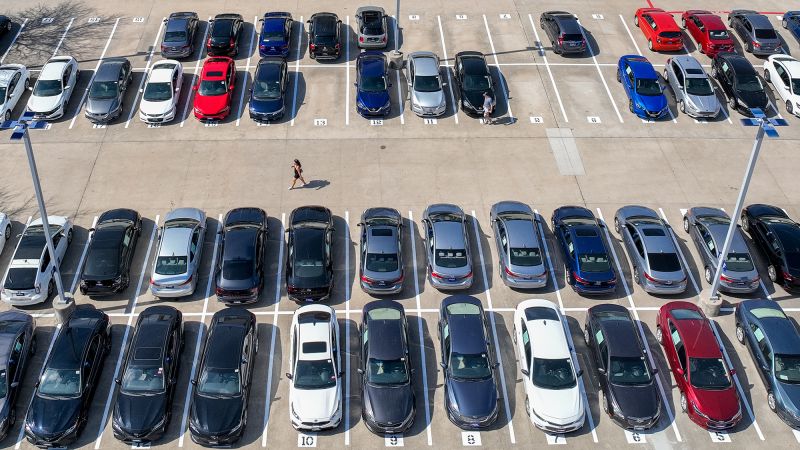A key group of American borrowers is falling significantly behind on their car loans. It’s yet another sign that the US economy is forming some serious cracks, leaving the most vulnerable in financial distress.
The percentage of subprime borrowers – those with credit scores below 670 – who are at least 60 days late on their car loans has doubled since 2021 to 6.43%, according to Fitch Ratings. That’s worse than during the past three recessions – during the Covid pandemic, the Great Recession or the dot-com bust.
America’s current subprime delinquency rate is at the second-highest level since the early 1990s. The only time it was higher: this past January. Cars are being repossessed at the highest rate since the Great Recession of 2008 and 2009.
It’s a disturbing trend to economists: Car loans are typically the last payments that Americans are willing to miss. They’re too important to their lives: Cars are essential tools to get to work, drive families and access food.
Record car prices and high interest rates, combined with other inflationary pressures, have sent average auto payments to record levels and have put significant stress on car owners.
Although the financial stress on subprime car borrowers has stabilized in 2025 after large increases in late payments and repossessions over the past two years, economists fear what might happen if the labor market grows considerably weaker and layoffs become more common.
For subprime borrowers, the default rate – those whose cars have been or are about to be repossessed – which stood at nearly 10% in September, according to Cox Automotive data. That’s down from a year ago but above the long-term average.
Those borrowers often have no choice but to default. They can’t sell their cars because they owe so much more than it is worth. They often have already missed payments on other obligations, such as mortgage payments or rent, as well as payments due on credit cards and student loans.
“There’s no room for error,” said Jonathan Smoke, chief economist at Cox Automotive.
Just over half of new car leases and more than three-quarters of new car loans made in the second quarter had monthly payments of $500 or more, and 46% of used car loans have payments of $500 or above, according to Experian. For new car loans, more than 17% have payments of more than $1,000.
Repair costs have also surged – at a time when many are holding onto their cars for longer to avoid splurging on a new one. Motor vehicle repair costs surged 15% year-over-year in August, according to the Bureau of Labor Statistics. That’s the most in nearly two years. And repair costs increased 5% between July and August, the biggest monthly increase on record.
Meanwhile, car insurance rates have increased significantly since the pandemic. In August, car insurance rose by the smallest annual rate in three years – but that still amounted to a hefty near-5% jump, well above the overall inflation rate.
The increased costs of owning and maintaining a car aren’t happening in a vacuum: They’re taking place after years of rising prices at the supermarket and across the economy. And two years ago, many student loan payments that were paused during the pandemic became due again. A year ago, delinquent student loan payments started counting against credit scores again, pushing some borrowers into lower credit ratings that could raise the rates they were charged on other loans, including car loans.
Elevated subprime delinquency rates demonstrate how beneath the surface of blockbuster stock market returns and strong overall economic growth, many consumers are hurting.
Tellingly, Americans with stronger credit scores don’t appear to be struggling to make car payments. The delinquency rate among prime borrowers has increased significantly but remains very low at less than 0.5%.
“There are no alarm bells going off for prime borrowers,” said Rod Chadehumbe, chief asset backed securities strategist at Bloomberg Intelligence.
The wide gap between delinquency rates of prime and subprime borrowers is another reminder of the so called K-shaped economy: Many Americans who have money in the stock market and own increasingly valuable homes are doing well and spending aggressively, but many others, especially lower-income consumers, are struggling to stay afloat.
A number of lenders who specialize in subprime car loans expect a growing percentage of their clients to default and have their car repossessed, said Pamela Foohey, a law professor at the University of Georgia and an expert in both auto finance and bankruptcies.
The repo business has been quite active lately. Subprime lenders build GPS features into cars to make it easier for teams repossessing the vehicles to find them, she said. The lenders can even disable the ignition of the cars to prevent owners from driving them once they’ve defaulted on the loan.
“The (repo) numbers indicate it’s probably close to the Great Recession in volume,” said George Badeen, who runs Midwest Recovery and Adjustment in Detroit, and is also president of one of his industry’s trade groups. “It’s a target-rich environment at the moment.”
